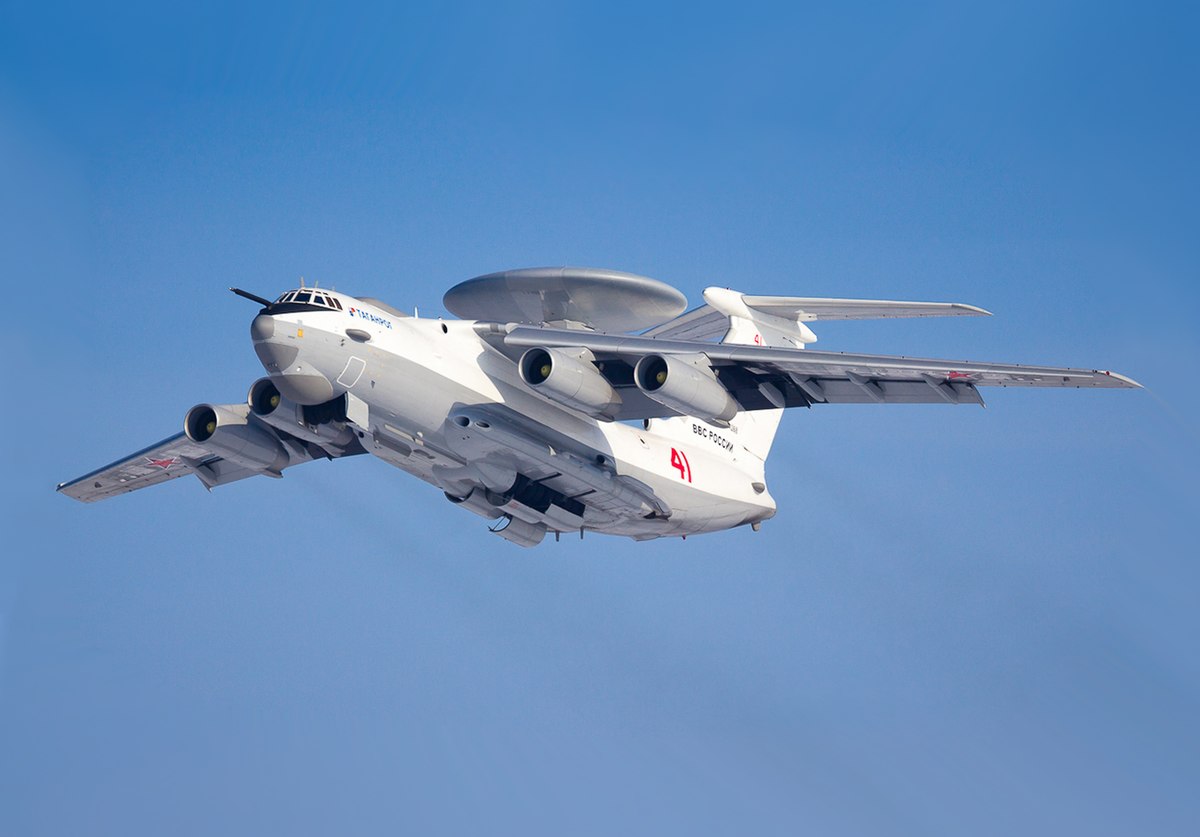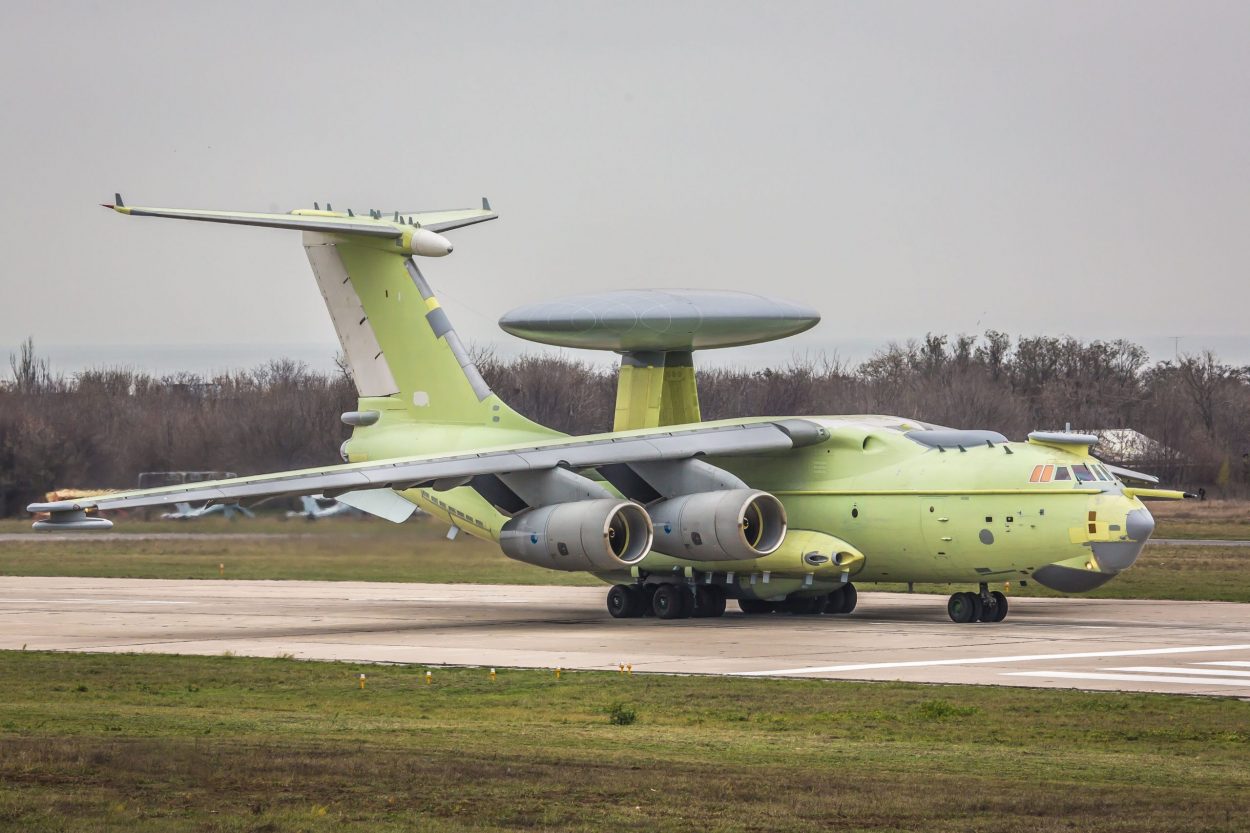A Russian military publication has claimed that western sanctions imposed on Russia are causing delays to the country’s next-generation Airborne Early Warning And Control (AEW&C) aircraft program, the A-100 Premier. This means A-100 will not available anytime before 2024.
The A-100 is meant to provide a considerable edge over the Cold War-era A-50 Mainstay being used by the Russian Aerospace Forces (VKS). The Premier program began in 2006, and the A-100 was previously scheduled to enter service in late 2020.
A recent article in the military and defense newspaper Voyenno-Promyshlenny Kuryer highlighted the A-100’s delayed schedule, citing an anonymous source within the Russian Ministry of Defense.
The deferment of the program’s schedule has been attributed to delays in the delivery of electrical components for the aircraft, particularly microchips, as a result of sanctions placed on Russia in recent years by the European Union, the United States, and individual countries.

“Electronics, like much aside, have come under Western sanctions, which have hurt the Premier project,” the article states. At the same time, Russian efforts to produce replacements for foreign-made microchips used in the A-100 “have encountered problems.”
The Voyenno-Promyshlenny Kuryer highlights a “strategic mistake” in the early development of the A-100 prior to the imposition of sanctions on Russia. The sanctions were imposed in reaction to its annexation of Crimea from Ukraine in 2014.
Additional sanctions were imposed in the aftermath of the poisoning of former spy Sergei Skripal and his daughter in the United Kingdom in 2018, as well as suspicions of Russian meddling in the 2016 US election that apparently brought Donald Trump to power.
Who Paralyzed The A-100 Program?
As the A-100 program began before the imposition of these sanctions, economic security considerations did not influence the sourcing of foreign components. While it is not stated in the report, it appears that the Russian Ministry of Defense is ultimately responsible for this decision.
The A-100 Premier is the result of collaboration between many Russian defense and aerospace companies. Beriev is in charge of integrating the radar and avionics into the airframe of the Il-76MD-90A transport aircraft, a much-modernized version of the Il-76 Candid. Aviastar-SP offers the Il-76MD-90A transport aircraft, a much-modernized version of the Il-76 Candid. Meanwhile, the Premier mission system is manufactured by Vega, a military electronics manufacturer.
The #Beriev A-100 AWACS aircraft performed its maiden flight pic.twitter.com/eEcpMrLXL2
— UAC Russia (@UAC_Russia_eng) November 20, 2017
The A-100 AEW&C plane took its maiden flight in 2017. The avionics and radio engineering complex of the aircraft were tested during the flight, according to Air Force Recognition.
The A-100’s delivery timeline, which began development in the early 2000s, has fallen behind schedule multiple times to date. The inaugural flight was supposed to take place in 2015, but it was pushed back to 2016, and then, once the Il-76MD-90A was chosen as the carrier, it was pushed back to 2017. The aircraft was supposed to be ready by 2020 which is now delayed by another four years.
Finally, the A-100 program’s excessive reliance on western electrical components reflects a broader malaise in Russia, which continues to lag behind in this field.
According to Voyenno-Promyshlenny Kuryer, Russia is at least 10 years behind the West in terms of these technologies. This is, at least in part, a relic of the Cold War, when Western economic restrictions prohibited the export of high-tech commodities to the Soviet Union.

Meanwhile, the VKS relies on its fleet of A-50 AEW&C aircraft, which began service in 1984. To stay relevant, the Mainstays are undergoing a mid-life upgrade to A-50U standard, which includes a new computing system with digital signal processing that is reported to be significantly more reliable than the original analog equipment.
The A-100 Premier Aircraft
The A-100 is a twin-engine airborne early warning and control (AEW&C) aircraft based on the airframe of the Il-76MD-90A (Il-476) military transport aircraft designed by Ilyushin Aviation Complex and manufactured by Aviastar-SP.
The Russian Air Force will employ the new aircraft for long-range detection and surveillance of airborne, land-based, and sea-based targets. It can also supply fighter and attack aircraft with airborne intelligence, surveillance, reconnaissance, and command and control in air-to-air or air-to-ground attack missions.
The A-100 is already known as “the flying mushroom” because of its unusual rotating radar dome above the fuselage. A circular radar dome mounted on two struts above the fuselage houses Vega’s Premier 476 dual-range, multi-position, panoramic active electronically scanned array (AESA) radar and two rotating phased array antennae.
To give a broader angle of coverage, phased array radars can execute mechanical bearing scanning as well as active electronic vertical phase scanning. The elevation angle of the radar beam is controlled electronically, while the azimuth angle is controlled mechanically by rotating the dome.
The AESA array, with a rotation duration of five seconds, improves the radar’s ability to track quick maneuverable targets.
The panoramic surveillance radars and cutting-edge computer systems onboard the aircraft will assist in identifying, detecting, and acquiring airborne targets in three axes at a distance of 600km, as well as surface targets at a distance of 400km.
The airborne radar warning and guidance system also includes friend or foe identification (IFF), radio transmission equipment, and a digital computer. To guide anti-aircraft missiles, target data is relayed to missile command stations over a command radio link.
With greater flying safety, the plane’s avionics system can acquire, mark, and track stationary and moving targets in both automated and manual modes. The aircraft’s position is determined using cutting-edge laser gyroscopes and quartz accelerometers.
PHOTO: «A-100LL» flying testbed for Russia's new AWACS «A-100» seen without radome at open doors at the Beriev Plant in Taganrog this weekend. The testbed is created from an old serial «A-50» RED 52 [RF-93953]. pic.twitter.com/Tnnk7UEAHI
— Missilito (@Missilito) May 20, 2019
The A-100 aircraft is outfitted with electronic intelligence (ELINT) and electronic warfare (EW) technologies to protect it from hostile weapons.
The A-100 AEW&C aircraft is powered by two contemporary PS-90A-76 engines, each with a thrust of 3,500kgf. The engine provides improved maneuverability over the Il-76MD-90A aircraft while reducing operational expenses. The aircraft has a flight time of about 260 minutes.
The need for an early warning aircraft becomes imperative for Russia, which has seen a rising NATO presence in the East European region and close to the Black Sea.
- Contact the author at sakshi.tiwari9555@gmail.com
- Follow EurAsian Times on Google News




